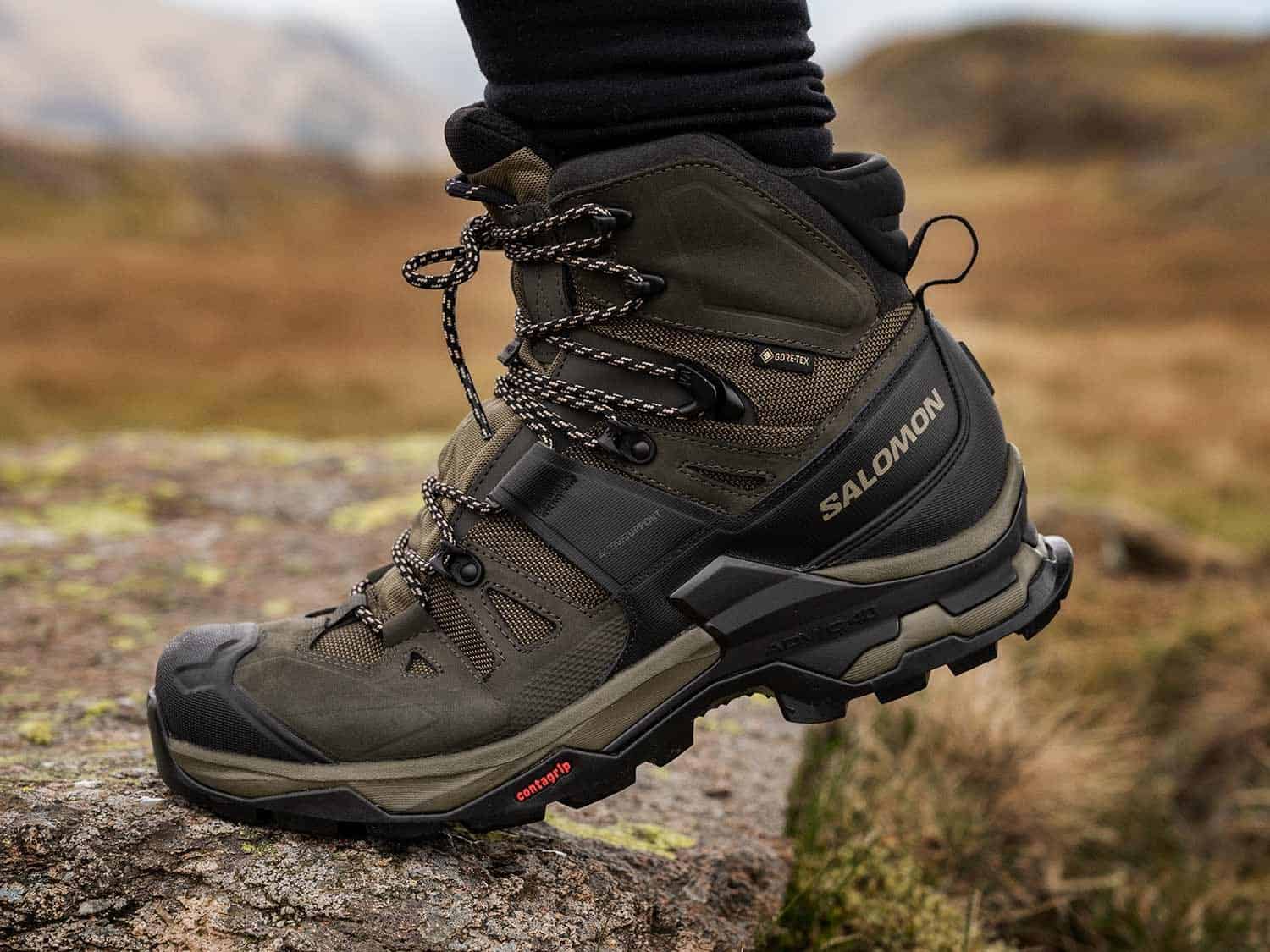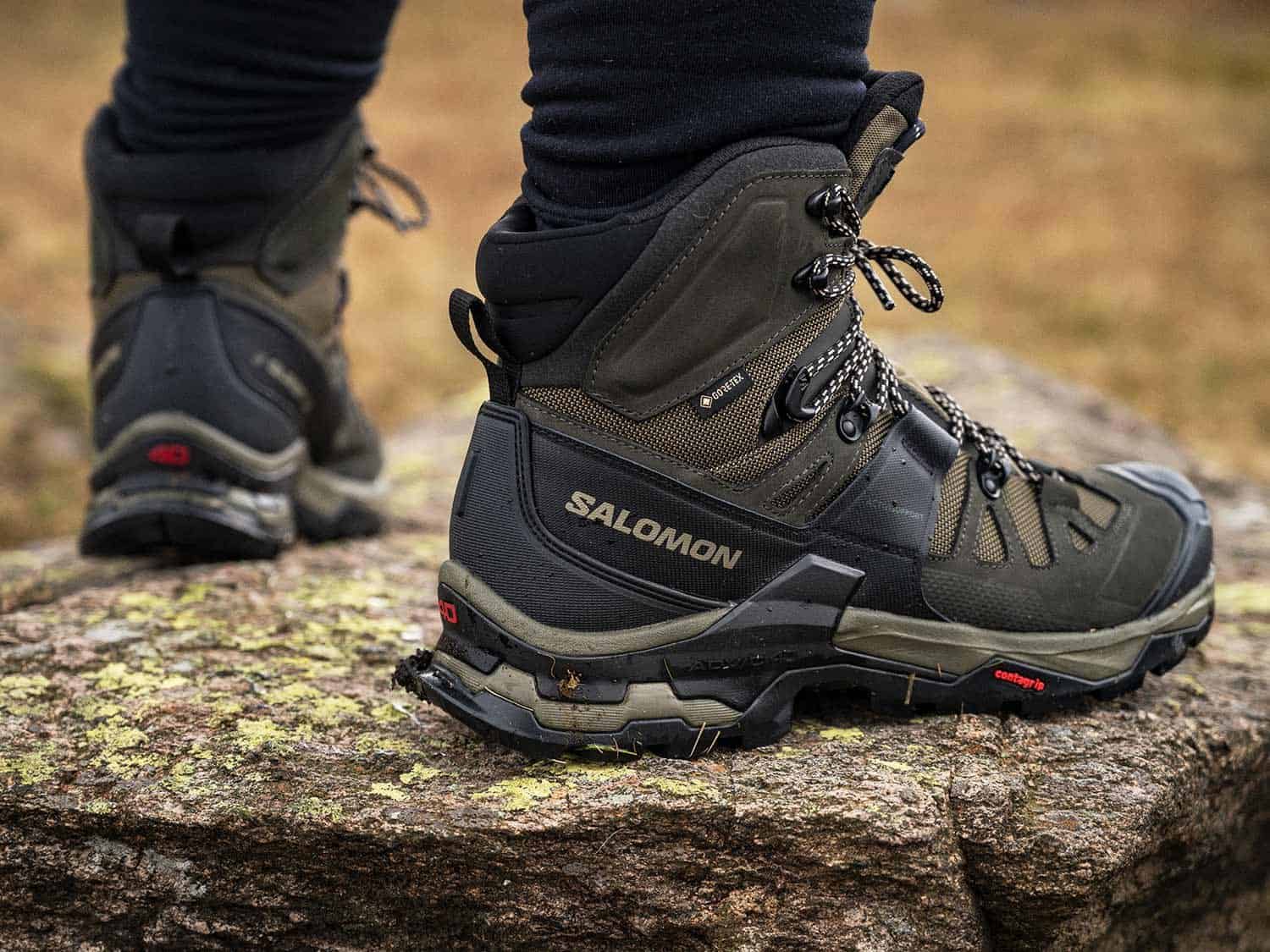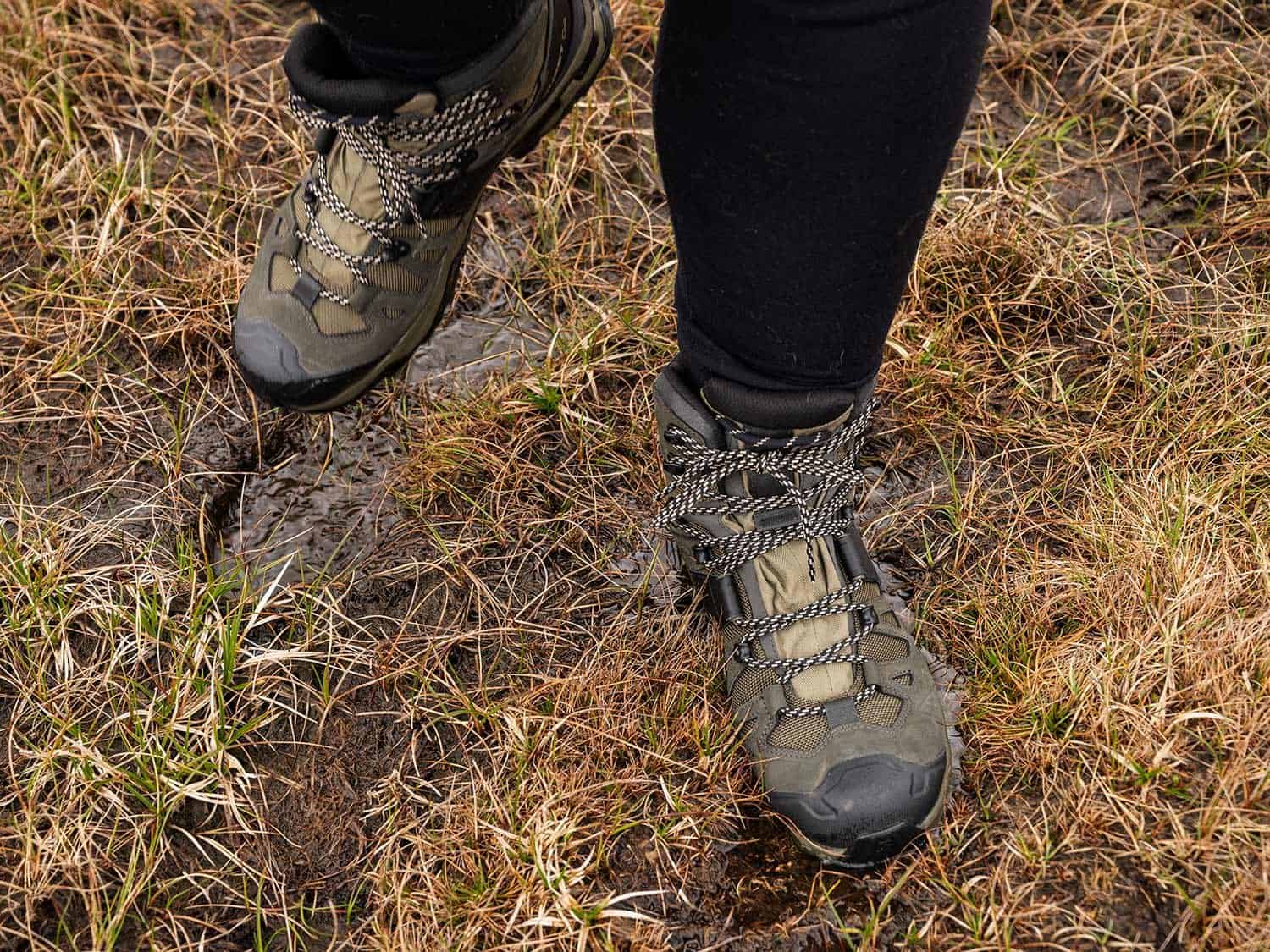The Salomon Quest 4 is an impressive, heavy duty hiking boot. They are rigid and tough, yet still very light for what they are. We think there are plenty of hikers for who these boots could be the only pair they need.
Table of Contents
TogglePros / Reasons to Buy
- Sturdy build
- Good foot and ankle support
Cons / Reasons to Avoid
- Took a while to break in
- Some may not like the rigid construction
Verdict
The Salomon quest 4 is certainly a substantial hiking boot. Salomon don’t expressly say it on their site, but they feel substantial enough that they could be B1 rated. These boots would certainly fit the bill for most hiking – from general trails right the way to routes that take you over more technically demanding terrain (though for high mountains and really extreme conditions, bulkier mountaineering boots still make more sense). For many hikers, these could be the only boots they need and these Salomon’s are built tough enough that we are sure they could las for many long years.
Compare to Similar Products
- On Cloudrock 2 Waterproof
- The North Face Hedgehog Fastpack
- Scarpa Ribelle Lite HD
- See our main reviews: 20 Best Waterproof Hiking Shoes
Get a closer look: See the Salomon Quest 4 Gore-tex in motion:
Analysis and Test Results
We’ve been very impressed by the Salomon Quest 4 Gore-Tex boots. They are a chunk and rigid pair of mid to high boots that offer exceptional durability and foot support. Some wearers might find the rigid design too constraining – especially if they’ve bene used to wearing lighter hiking shoes previously. However, we also think there are plenty of potential buyers out there who will see the rigidity of these boots as a definite bonus. Indeed, whilst Salomon don’t specifically say these boots are B1 rated they feel rigid enough that they either could be or could almost be. That’s a big deal, as it makes them suitable for hiking in more extreme environments and even some mountaineering. Considering their ruggedness, these boots are exceptionally light, and we think that provided you are OK with the rigidity, they could be the only pair of hiking boots that many people would need.
Performance Comparison
Traction
The Salomon Quest 4 boots make use of one of Salomon’s own in-house sole units. It offers a deep and fairly aggressive grip and, on the trail, offers excellent grip and traction, even in wet and slipper conditions. These boots are not explicitly B rated, but they feel about as rigid as some of the B1 boots our reviewers have owned and this can help with providing a sure footing on really uneven or more technically demanding terrain.
Breathability
These boots are clearly intended for use by those venturing into the hills and mountains. They do have large mesh sections on their upper, which will help with breathability (and this is backed with a water-resistant Gore-Tex membrane), but the truth is that these Salomon Quest 4 boots prioritize insulation over absolute breathability. That said, our reviewer has worn these on summer hikes, with temperatures around 24C/75F and did not find them to get excessively warm – though that could be a different story were you to wear them hiking around Southern California in the summer, for instance!
Ankle Support
These Quest 4 boots have a slightly higher than normal ankle cuff. Salomon call it a ‘high’ rather than ‘mid’ shape. This can be tensioned with the multi-zone lacing system and offers, as you might expect, great ankle support. The ankle support is not up to the same level as a more rigid B2 or B3 rated mountaineering boots, but it’s still very good and certainly amongst the best in our round up. Ankle support is important on more technically demanding or difficult hiking routes as it means the boots will provide some degree of protection to your ankles if you trip or stumble. Good ankle support can help prevent twisted ankles or worse and also take the edge off impacts. In this regard, our reviewer was very impressed by these boots, though it’s worth noting that if you’re not used to hiking with more rigid boots, you might find this aspect of the boots takes some time to get used to.
Arch Support
The Salomon Quest 4 boots come with a subtly shaped footbed that offers a little arch support. We think that most buyers will be just fine with this, and Salomon’s offering here isn’t much different to the other products we’ve assessed. For those who require more substantial arch support, the insoles in these boots can be removed and replaced with something that offers just this. This is an inexpensive way to fine tune the fit and potentially improve the comfort of your boots should you need it.
Fit
The Salomon Quest 4 Gore-Tex boots are available in sizes from US 5/ UK 3.5/ EU 36 up to US 11/ UK 9.5/ EU 44 and Salomon say they are suitable for those with normal to wide feet. Our reviewer has slightly wide feet and found they fit very well indeed. Larger sizes are available, if needed, in the men’s version of these boots.
Materials
The sturdy Salomon Quest 4 boots make use of a mixture of synthetic materials and leather in their construction. They also feature a Gore-Tex membrane to help the boots stay water-resistant whilst still being breathable. Leather was once the primary material used in hiking footwear, but, in recent years, lightweight and hard-wearing synthetic materials have increasingly taken its place. Whilst the Quest 4 boots only use some leather in their uppers, some buyers will certainly value the presence of this material as it has a proven reputation for durability.
Appearance
The Salomon Quest 4 boots have a utilitarian but still up to date look. Their design is certainly not as striking as some others, but it certainly can’t be described as traditional either. The boots are offered in a few different muted and earthy colorways, with contrasted panels and red accents providing some additional interest in the design. Some – and this would include both those who prefer bolder more fashionable designs alongside those who prefer more traditional hiking gear – may find the Quest 4 boots look a bit too industrial, but we don’t mind the functional design.
Durability
We’ve been very impressed by the solid-feeling build of the Salomon Quest 4 boots. Indeed, given what we think is their intended use, these boots need to feel solid as they can be expected to find themselves in harsh conditions and receiving far less than perfect treatment on the trail. With hard wear, and time spent on demanding trails, even the most durable footwear will wear out with time, but we have no doubt that these Salomon boots could last a long time indeed.
Weight
Salomon claim a weight of 1070g/2lb 6oz for the pair for the Quest 4 boots. That might seem heavy when compared to most of the other products in our round-up, but, when you consider how supportive and strong these boots are, and the heavier mountaineering boots they could easily replace for some types of hiking or trekking, then we think the weight is actually very reasonable indeed. Weight carried on your feet will fatigue you far quicker than the same weight carried elsewhere. We think that there are some applications – mountaineering on les technical routes in better weather, for instance – where these boots could certainly replace a pair of B1 boots and maybe even a pair of B2 boots. When you bear in mind that some of these boots can weigh more for an individual boot than a pair of these Quest 4 boots, then the Salomon’s present a really attractive option.
Insoles
The Salomon Quest 4 boots come with a fairly generic, cushioned insoles. There’s not much to say about them, other than that we think that most buyers of these boots will be perfectly happy with them. However, if you feel the fit of your boot isn’t quite right or if you want more arch support tor deeper cushioning, then swapping out the supplied insoles with one of any number of readily and inexpensively available aftermarket alternatives is a great way to fine-tune the comfort or even fit of your hiking boots.
Break-in Period
No footwear is completely without a breaking in period. If you remember older style, bulky hiking boots, you’ll no doubt also remember lengthy and often painful breaking in periods before a pair of boots was reliably comfortable. However, that’s different with modern boots and most of the products we’ve assessed in our round up have a much easier breaking in period. That said, due to their rigid construction, our reviewer did find the Salomon Quest 4 boots to have a longer breaking-in period than some of the other products in this round-up and did experience some notable rubbing – though no blisters. We certainly wouldn’t recommend wearing these boots on a long hike straight from the box, but after a few shorter ‘warm up’ walks, they were comfortable enough to take out on longer hikes. A pair of well-fitting hiking socks – which are generally that bit thicker or even specifically padded relative to regular socks, is also good idea, but especially so when breaking-in boots where they can really help keep rubbing from the boots under control.
Lacing System
The Salomon Quest 4 boots use regular laces and a multi-zone lacing system. Laces may not seem very exciting, but they are actually a really versatile way of securing your shoes, as they allow a great deal of flexibility in terms of tensioning – allowing you to selectively loosen or tighten your boot to fit the individual shape of your foot. Many don’t realize it, but you can also change the lacing pattern you use to further refine the fit of your boots. We have a guide to this which is well worth checking out.
Toe Protection
The Salomon quest 4 boots feature a hardened rubber section around the toes. Whilst this isn’t in the same league as a dedicated and more specialized mountaineering boot, it’s also amongst the best offered by any product in our round-up and will certainly help protect your toes during trips, tumbles or simply when you accidentally kick into a rock. Toe protection is especially important on more technically demanding terrain and can really help prevent some nasty injuries.
Hiking Shoes v Hiking Boots
For general hiking on good quality trails, the choice between hiking boots and shoes is really down to personal choice. Some will prefer the extra support and foot protection offered by a rigid boot, whilst others will prefer the lighter weight and mobility offered by shoes. For more demanding or technical trails, though, boots, and the added support they provide make a of sense and we’d still say they have the advantage. These Salomon Quest 4 boots are interesting as they are rigid enough to replace B1 and maybe even B2 boots on some types of trail whilst coming in at a weight point that would have been unheard of for boots this rigid until relatively recently.
Conclusion
The Salomon Quest 4 boots are certainly an interesting proposition. Some people – especially those who prefer lighter hiking shoes that allow for greater ankle mobility – may not like their rigidity, but we think this is their greatest asset – especially when considered alongside their weight. These boots could, we believe, easily do the job of dedicated B1 and even, in some circumstances, B2 mountaineering boots. These specialized boots are typically way more expensive and way heavier than these Salomon boots. With this in mind, we think they become a very attractive option and we think that they may even be the only pair of hiking boots that some people will need.
Disclaimer: This article contains Affiliate Links. You won’t pay any more for buying through these links, but we may receive a commission from any purchases made through them. As an Amazon Associate, I earn from qualifying purchases. If you choose to support us by buying through our links, we thank you as it helps us to continue providing the resources we do to help you enjoy the outdoors more!




